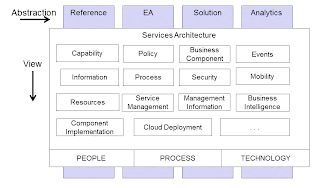Will Enterprise Architecture Ever “Cross the Chasm?”
The profession of Enterprise Architecture is beginning to emerge from its early stages of development. The number of people professing the title of Enterprise Architect has grown from a relative few in the 1990s to thousands today. On LinkedIn, a popular social networking site for professionals, the “Enterprise Architecture Network” discussion group boasts over 79,000 members.
There is a great deal of demand for Enterprise Architecture services. Large consulting firms like Accenture, Deloitte, PWC, and Wipro, large software vendors like Microsoft and IBM, large hardware vendors like Fujitsu and Hewlett Packard, and outsourcing firms like Computer Sciences Corporation, have all developed service offerings that revolve around providing Enterprise Architecture as a service to their clients.
While the field has grown, the proliferation of voices, methods, frameworks, and generally inconsistent advice in the field of EA has also grown. The number of “EA Frameworks” has grown to include a wide array of overlapping bodies of work. Included in this list are GERAM, TOGAF, FEAF, MODAF, DODAF, PEAF, E2AF, Zachman, and many others. Jaap Schekkerman has released three editions of his 250+ page book “How to Survive in the Jungle of Enterprise Architecture Frameworks” which attempts to compare only 15 of them!
Unfortunately this proliferation has created a problem that is common among emerging professions: a lack of maturity. As Geoffrey A. Moore pointed out in his landmark book, “Crossing the Chasm,” the market for a high-tech product will self-segment into Early Adopters (accounting for less than 20% of the market) and the more pragmatic customers in the Early Majority, Late Majority, and Laggards categories. Viewing Enterprise Architecture as a new high-tech product provides useful insight into why EA has failed to “cross the chasm” from early adoption to the pragmatic majority.
In order for Enterprise Architecture to cross the chasm, there has to be an intentional strategy to gain a foothold in one target market that is part of the Early Majority, and then to use the success of Enterprise Architecture in that space to build the credibility needed for other segments to adopt.
Unfortunately, while EA has been successful in some target markets in the Early Majority (like Telecom and Federal), the lack of consistency in the approach, terminology, and even value proposition of EA across industries poses an obstacle for increasing EA adoption. In other words, the success of EA in one or two areas is failing to help EA gain a foothold among other industries. Could it be because they don’t use the same words to describe success?
Unable to depend on a broader “EA movement,” each EA team is waging a lonely struggle for relevance and ongoing support within their own enterprise. To remain relevant, EA teams have often focused on “low hanging fruit,” immediately valuable initiatives that generate results quickly but often fail to address long-standing challenges. The mantra of modern Enterprise Architecture has become “provide immediate value immediately,” a position that relegates long-term thinking and investment to another day. Ironically, it is this long-term thinking and investment that EA is supposed to provide.
It should come as no surprise that a profession that is designed to provide value in the long term is struggling with demonstrating short-term results. Many EA programs fail as a result of this struggle. In a widely publicized study commissioned by EA tools vendor IDS Sheer, Jonathan Broer, then an undergraduate researcher from Rotterdam University, conducted a study of 191 organizations. The startling results of his survey suggest that up to 66% of all EA-sponsored efforts have failed to produce the expected results. Of the root causes cited: the lack of business awareness of Enterprise Architecture, lack of executive and stakeholder support, and the inability to provide a rapid return on investment.
There have been a few studies designed to examine the reason for the lack of EA to deliver rapid value. There have been no studies developed to examine the reason that EA success in some sectors have failed to translate to others.
In summary, EA stands at a crossroads. The profession of Enterprise Architecture is plagued by multiple problems.
- Enterprise Architecture is poorly defined by a wide array of discordant opinions, overlapping and industry-specific frameworks.
- Enterprise Architecture is hobbled by an inability to build momentum among Early Majority companies on the adoption curve.
- Enterprise Architecture has responded by focusing on the wrong set of problems: describing short-term-quick-win initiatives using methods and tools designed to produce long-term value.
